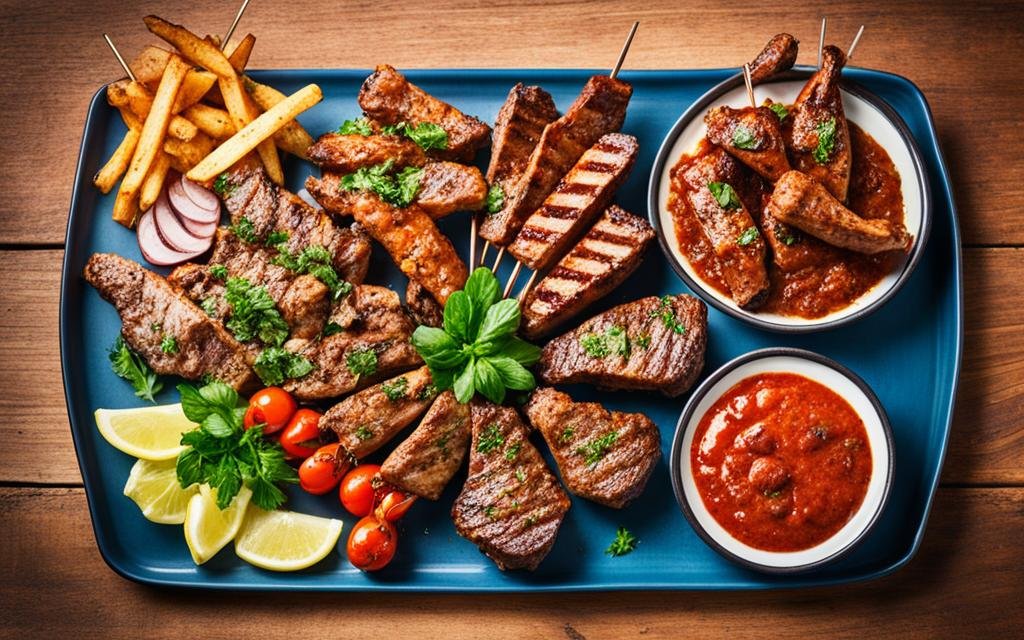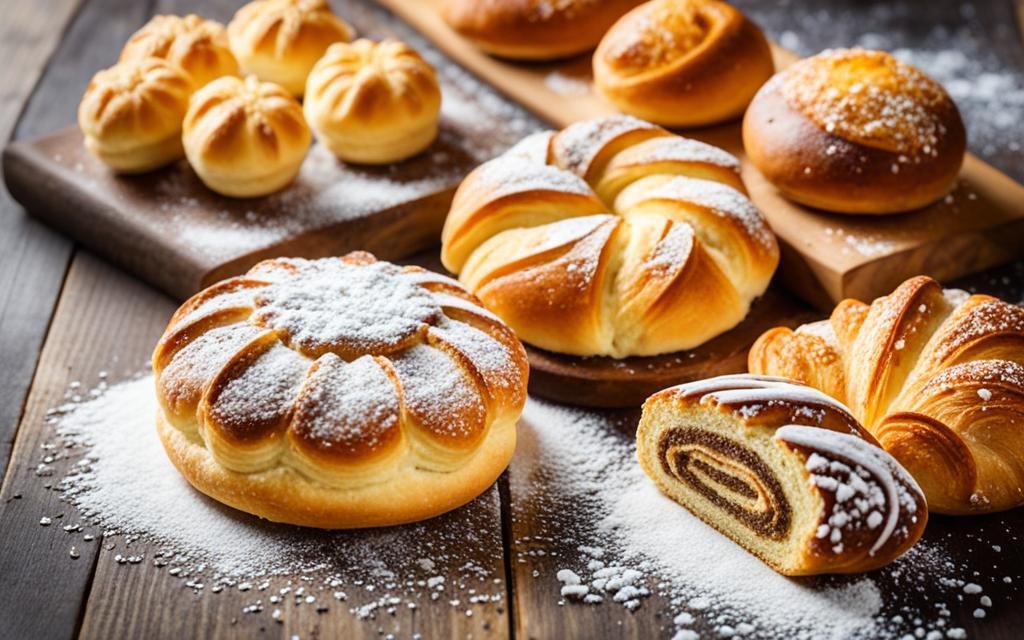Albania, a small Balkan country nestled between the Adriatic and Ionian Seas, boasts a rich and diverse culinary heritage that has been shaped by its unique geographic location and cultural influences. The Albanian food scene is a delightful blend of Mediterranean and Balkan flavors, featuring a wide array of traditional dishes and regional specialties that showcase the country’s bountiful natural resources and traditional cooking techniques.
Introduction to Albanian Cuisine
The rich and diverse culinary traditions of Albania have been shaped by the country’s unique geographic location and centuries-old cultural influences. Situated at the crossroads of the Mediterranean and Balkan regions, Albania’s cuisine has evolved over time, blending the flavors and cooking techniques of its neighboring countries.
Albania’s regional diversity is reflected in its culinary traditions, with each area of the country contributing distinct specialties that showcase the geographic factors and historical roots of the local Albanian cuisine. From the coastal regions’ seafood-centric dishes to the mountainous areas’ hearty, meat-based offerings, the Albanian food scene is a captivating tapestry of Mediterranean and Balkan flavors.
Centuries of cultural influences, including the legacy of the Ottoman Empire and the Mediterranean culinary traditions, have left an indelible mark on the Albanian culinary landscape. This blend of regional diversity and historical roots has given rise to a cuisine that is both unique and deeply rooted in the country’s rich culinary traditions.
| Key Aspects of Albanian Cuisine | Influences and Characteristics |
|---|---|
| Geographic Factors | Albania’s strategic location at the intersection of the Mediterranean and Balkan regions has shaped its diverse culinary traditions, with coastal areas featuring seafood-based dishes and mountainous regions specializing in hearty, meat-based offerings. |
| Historical Roots | The Albanian cuisine has been influenced by centuries of cultural exchange, including the legacy of the Ottoman Empire and the culinary traditions of the Mediterranean region. |
| Regional Diversity | Each region of Albania contributes distinct culinary specialties that reflect the local geographic factors and historical roots of the Albanian food scene. |
| Culinary Traditions | The Albanian cuisine is a tapestry of Mediterranean and Balkan flavors, showcasing the country’s rich cultural influences and historical development. |
This introduction to Albanian cuisine sets the stage for a deeper exploration of the country’s captivating culinary traditions, regional specialties, and the unique cultural influences that have shaped this diverse and flavorful food landscape.
Albanian Food: A Delectable Blend of Tradition and Flavor
The cuisine of Albania is a captivating fusion of Mediterranean and Balkan culinary traditions, resulting in a unique and flavorful gastronomic experience. The country’s strategic location, nestled between the Adriatic and Ionian Seas, has allowed Albanian food to absorb and reflect the diverse flavors and cooking techniques of its neighboring regions.
At the heart of traditional Albanian cuisine lies a deep appreciation for seasonal ingredients and locally sourced produce. Albanian cooks skillfully harness the bounty of their land, crafting dishes that celebrate the vibrant flavor profiles of the region. From the sun-drenched coastal areas to the lush, verdant mountains, the Balkan and Mediterranean influences converge, creating a culinary tapestry that is both rich in history and bursting with contemporary flair.
Whether it’s the smoky, grilled meats of the north or the fragrant, slow-cooked stews of the south, Albanian food offers a captivating array of regional specialties that showcase the country’s culinary diversity. The use of seasonal ingredients and local produce ensures that each dish is a celebration of the region’s finest offerings, reflecting the deep-rooted connection between the land and the table.
| Signature Albanian Dishes | Key Ingredients | Regional Variations |
|---|---|---|
| Byrek (Savory Pie) | Phyllo dough, cheese, spinach, meat | Byrek me Djathë (Cheese Byrek), Byrek me Spinar (Spinach Byrek) |
| Tavë Kosi (Baked Lamb and Rice) | Lamb, yogurt, rice, onions, garlic | Tavë Elbasani (Elbasani-Style Baked Lamb) |
| Tullumba (Fried Dough Pastry) | Flour, sugar, honey, oil | Tullumba e Gjirokastrës (Gjirokaster-Style Tullumba) |
As you delve into the rich tapestry of Albanian cuisine, you’ll discover a culinary landscape that seamlessly blends the traditional and the contemporary, offering a truly captivating gastronomic experience that celebrates the country’s rich cultural heritage.

Key Ingredients in Albanian Cooking
The foundation of Albanian cuisine is built upon a diverse array of high-quality, locally-sourced albanian ingredients that reflect the country’s rich natural resources and traditional cooking methods. From the verdant mountain regions to the bountiful coastal specialties, Albanian cooks have access to a wide variety of fresh, flavorful staple vegetables, herbs, dairy products, meat, and seafood that are integral to the creation of the country’s iconic dishes.
The local produce found throughout Albania is a testament to the region’s agricultural bounty and the deep-rooted traditional cooking practices that have been passed down through generations. Staple vegetables like peppers, tomatoes, eggplants, and potatoes are combined with fragrant herbs such as oregano, basil, and parsley to create the foundation for many beloved Albanian dishes.
| Ingredient Category | Examples |
|---|---|
| Vegetables | Peppers, Tomatoes, Eggplants, Potatoes, Onions, Garlic |
| Herbs | Oregano, Basil, Parsley, Mint, Dill |
| Dairy Products | Yogurt, Cheese (e.g., Gjizë, Bryndza, Gjizë e Bardhë), Cream |
| Meat | Lamb, Beef, Pork, Chicken |
| Seafood | Sardines, Anchovies, Octopus, Mussels, Shrimp |
The diverse albanian ingredients found throughout the country’s regions contribute to the rich tapestry of Albanian cuisine, reflecting the country’s unique geography, cultural heritage, and centuries-old culinary traditions.
Meat Dishes: A Carnivore’s Delight
Meat is a central component of traditional Albanian cuisine, with a wide range of dishes that cater to the palates of dedicated carnivores. From the smoky, grilled meats of the north to the slow-cooked, hearty meat-based stews and casseroles of the central and southern regions, Albanian food offers a mouthwatering array of meat-centric specialties that showcase the country’s rich culinary heritage.
One of the standout Albanian meat dishes is the iconic lamb dishes, which are revered for their tender, succulent texture and flavorful profiles. These lamb-based delicacies are often prepared using traditional cooking techniques, such as slow-roasting or grilling, which allow the natural flavors of the meat to shine and create a harmonious balance with the accompanying herbs and spices.
In addition to lamb, Albanian cuisine also features an array of roasted meats and grilled meats, each with its own unique regional variations. From the smoky, chargrilled qebapa (grilled meat patties) of the north to the succulent, slow-roasted prêtja (roasted meat) of the central regions, these meat dishes are a testament to the country’s mastery of traditional cooking techniques and their ability to extract the maximum flavor from the finest local ingredients.

Whether you’re indulging in a hearty meat-based stew, savoring a perfectly grilled meat dish, or exploring the regional specialties of Albanian cuisine, the country’s love affair with meat is undeniable. These meat dishes not only showcase the culinary prowess of Albanian cooks but also serve as a delicious representation of the country’s rich cultural heritage and the enduring connection between its people and the land they call home.
Vegetarian Delights: Exploring Albania’s Plant-Based Offerings
While meat dishes hold a prominent place in Albanian cuisine, the country’s culinary landscape also boasts a rich array of delectable albanian vegetarian dishes that celebrate the abundance of fresh, seasonal produce and the ingenuity of Albanian cooks in crafting flavorful, plant-based cuisine. From legumes and grains to an array of vegetable-based dishes, Albania’s regional specialties and traditional cooking methods offer a diverse and satisfying range of options for those seeking to explore the country’s plant-based offerings.
One such standout dish is the beloved byrek, a savory vegetable-based dish that can be found in various iterations across Albania. These flaky, phyllo-wrapped pies are filled with a delectable blend of seasonal produce, herbs, and cheese, creating a harmonious balance of flavors and textures that showcase the country’s culinary creativity.
Equally captivating are the hearty vegetable stews and casseroles that are popular in many Albanian regions. Slow-simmered with an array of fresh vegetables, legumes, and fragrant spices, these plant-based dishes offer a comforting and satisfying dining experience that celebrates the traditional cooking methods of Albania.
| Vegetarian Dish | Key Ingredients | Region of Origin |
|---|---|---|
| Byrek | Phyllo dough, seasonal vegetables, herbs, cheese | Throughout Albania |
| Vegetable Stew | Fresh vegetables, legumes, spices | Central and Southern Albania |
| Leqe me Oriz | Spinach, rice, onions, garlic, olive oil | Northern Albania |
| Veg Dolma | Stuffed vegetables, rice, herbs, tomato sauce | Southern Albania |
Beyond the beloved byrek and hearty stews, Albania’s vegetarian dishes also include delightful offerings like the leqe me oriz, a delicate dish of spinach, rice, onions, and garlic, and the veg dolma, a stuffed vegetable creation that showcases the country’s regional specialties and traditional cooking methods.
Whether you’re a dedicated vegetarian or simply seeking to explore the diverse flavors of Albania’s plant-based cuisine, the country’s vegetarian delights offer a delectable journey through its seasonal produce, legumes, and grains, all expertly crafted by the skilled hands of Albanian cooks.
Albanian Breads and Pastries
Bread and pastries hold a revered place in Albanian culinary traditions, with a diverse array of regional specialties that showcase the country’s rich baking techniques and the ingenuity of its skilled artisans. From the fluffy, traditional flatbreads to the decadent sweet pastries and savory pies, the Albanian baking landscape is a captivating blend of albanian breads and albanian pastries that reflect the country’s unique cultural heritage.
At the heart of Albania’s breadmaking tradition lie the iconic traditional flatbreads, such as the flaky, wood-fired lepëshe and the pillowy-soft kulac. These breads are not merely sustenance, but a testament to the country’s deep-rooted baking techniques and the intricate interplay of local ingredients. The preparation of these traditional flatbreads often involves intricate folding and shaping methods, creating a distinctive texture and flavor profile that is uniquely Albanian.
Complementing the savory traditional flatbreads are the indulgent albanian pastries, ranging from the buttery, flaky byrek (a type of savory pie) to the delicate, sugar-dusted baklava and the rich, creamy kadaif. These sweet pastries and desserts showcase the mastery of Albanian bakers, who seamlessly blend local ingredients and traditional baking techniques to create decadent treats that delight the senses.
| Traditional Albanian Breads | Traditional Albanian Pastries |
|---|---|
| Lepëshe (Flaky, Wood-Fired Flatbread) | Byrek (Savory Pie) |
| Kulac (Pillowy-Soft Flatbread) | Baklava (Flaky, Honey-Sweetened Pastry) |
| Sokollata (Cornmeal-Based Flatbread) | Kadaif (Shredded Wheat-Based Dessert) |
| Petulla (Fried Dough Fritters) | Trilece (Soaked Sponge Cake) |
The rich tapestry of albanian breads and albanian pastries is further enhanced by the diverse regional specialties found throughout the country. Each region has its own unique take on traditional baked goods, reflecting the local ingredients, baking techniques, and cultural influences that have shaped the country’s culinary heritage over centuries. Exploring the albanian breads and albanian pastries of Albania is a delightful journey through the country’s vibrant gastronomic landscape.

Drinks and Beverages in Albanian Culture
Beverages and drinks hold a special place in Albanian culture, with a rich and diverse selection of both alcoholic and non-alcoholic options that are deeply interwoven with the country’s history, traditions, and social customs. From the celebrated raki, a potent anise-flavored brandy, to the robust and flavorful Albanian wines, the country’s beverages reflect the vibrant regional specialties and the enduring influence of Mediterranean and Balkan traditions.
At the heart of Albanian non-alcoholic drinks is the ubiquitous Albanian coffee, a cherished ritual that brings people together. Served in small, ornate copper pots, the strong, aromatic brew is an integral part of social gatherings, business negotiations, and everyday interactions, showcasing the cultural significance of this timeless beverage.
Beyond coffee, Albanian beverages also include a variety of refreshing, fruity options, such as the tangy lemonata (lemonade) and the sweet, fizzy sode (soft drinks). These non-alcoholic choices are particularly popular during the hot summer months, providing a cooling respite and a taste of the country’s vibrant regional specialties.
The alcoholic drinks of Albania also hold a prominent place in the country’s culture, with raki and wine being the most widely consumed and celebrated. Raki, a fiery and flavorful spirit, is often enjoyed with traditional Albanian cuisine and as a social lubricant, while the country’s diverse wine regions produce a range of red, white, and rosé wines that showcase the unique terroir and winemaking traditions of the Balkan nation.
Beyond these iconic beverages, Albania also boasts a variety of other traditional alcoholic drinks, such as the herbal-infused raki e bimëve and the sweet, fortified vërë (wine). These regional specialties reflect the country’s rich cultural heritage and the ingenuity of its master distillers and winemakers.
Drinks and beverages in Albanian culture are not merely means of quenching thirst or getting intoxicated; they are deeply rooted in the country’s cultural significance, serving as catalysts for social interaction, markers of hospitality, and embodiments of the nation’s enduring culinary traditions.
Eating Etiquette and Customs
Dining in Albania is not just about the savoring the delectable albanian food and traditional albanian cuisine; it is a deeply rooted cultural experience that is steeped in mealtime traditions, social interactions, and a profound sense of hospitality. Understanding the nuances of albanian dining customs and cultural practices is essential for fully immersing oneself in the country’s rich culinary heritage.
At the heart of albanian eating etiquette is the concept of communal dining, where family and friends gather around the table to share not only a meal but also stories, laughter, and a deep sense of community. Meals are often long, leisurely affairs, with multiple courses and ample time for conversation and social interaction.
Hospitality is paramount in Albanian culture, and this is reflected in the way meals are served and shared. Hosts take great pride in presenting an abundance of delicious dishes, often encouraging guests to sample a wide variety of regional specialties and local produce. It is considered impolite to refuse food or drink, as doing so can be perceived as a rejection of the host’s generosity.
| Albanian Dining Etiquette | Customs and Traditions |
|---|---|
| Arrival and Seating | Guests are expected to arrive on time and wait to be seated by the host. Elders and respected guests are typically given the most prominent seats at the table. |
| Serving and Eating | Dishes are often served family-style, with guests encouraged to help themselves. It is considered polite to sample a bit of each dish. Eating with the right hand is the norm, and using utensils is expected. |
| Conversation and Etiquette | Lively conversation and storytelling are integral to the dining experience. Guests should avoid controversial topics and always address elders with respect. Leaving food on one’s plate is seen as a sign of satisfaction. |
| Departure and Gratitude | When the meal is finished, guests should express their gratitude to the host and may even offer to help with cleaning up. Departing guests are often given small gifts or leftovers to take home. |
By embracing the albanian dining customs and mealtime traditions, visitors can deepen their understanding and appreciation of the country’s rich culinary culture and social interactions. This cultural immersion enhances the overall dining experience and allows for a true connection with the hospitality that is so deeply ingrained in Albanian society.
Albanian Cooking Techniques and Methods
The culinary traditions of Albania are deeply rooted in the country’s diverse regional influences and centuries-old cooking techniques. From the traditional grilling and roasting methods of the north to the slow-cooked, braised dishes of the central and southern regions, Albanian cuisine showcases a rich tapestry of cooking styles that have been shaped by the country’s unique geographic location and cultural heritage.
The influence of the Ottoman Empire and the Mediterranean region can be seen in the way Albanian cooks approach their craft, with techniques like slow simmering, braising, and the use of aromatic spices and herbs. These methods, combined with the abundance of locally sourced ingredients, have given rise to a diverse array of flavorful dishes that reflect the Albanian culinary heritage.
Regional variations are also a hallmark of Albanian cooking, with each area of the country boasting its own signature techniques and flavor profiles. From the wood-fired grilling of the northern highlands to the slow-roasted meats and vegetables of the coastal regions, the Albanian cooking techniques are a testament to the ingenuity and resourcefulness of the country’s cooks, who have harnessed the bounty of their natural surroundings to create a truly distinctive and delectable cuisine.



